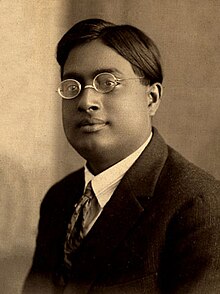Satyendra Nath Bose
| Satyendra Nath Bose Padma Vibhushan, FRS |
|
|---|---|

Satyendra Nath Bose in 1925
|
|
| Native name | সত্যেন্দ্রনাথ বসু |
| Born |
1 January 1894 Calcutta, Bengal Presidency, British India |
| Died | 4 February 1974 (aged 80) Calcutta, India |
| Nationality | Indian |
| Fields | Physics |
| Institutions |
University of Calcutta University of Dhaka Visva-Bharati |
| Education | Hindu School |
| Alma mater | University of Calcutta |
| Academic advisors |
Jagdish Chandra Bose Prafulla Chandra Ray |
| Doctoral students |
Purnima Sinha Partha Ghose Siva Brata Bhattacherjee |
| Other notable students |
Mani Lal Bhaumik Lilabati Bhattacharjee |
| Known for |
Bose–Einstein condensate Bose–Einstein statistics Bose–Einstein distribution Bose–Einstein correlations Bose gas Boson Ideal Bose equation of state Photon gas |
| Influences | Albert Einstein |
| Notable awards |
Padma Vibhushan Fellow of the Royal Society |
| Spouse | Ushabati Bose (née Ghosh ) |
Satyendra Nath Bose, FRS (/boʊs/; Bengali: Sôtyondronath Bosu; 1 January 1894 – 4 February 1974) was an Indian physicist from Bengal specialising in theoretical physics. He is best known for his work on quantum mechanics in the early 1920s, providing the foundation for Bose–Einstein statistics and the theory of the Bose–Einstein condensate. A Fellow of the Royal Society, he was awarded India's second highest civilian award, the Padma Vibhushan in 1954 by the Government of India.
The class of particles that obey Bose–Einstein statistics, bosons, was named after Bose by Paul Dirac.
A self-taught scholar and a polymath, he had a wide range of interests in varied fields including physics, mathematics, chemistry, biology, mineralogy, philosophy, arts, literature, and music. He served on many research and development committees in sovereign India.
Bose was born in Calcutta (now Kolkata), the eldest of seven children. He was the only son, with six sisters after him. His ancestral home was in village Bara Jagulia, in the district of Nadia, in the state of West Bengal. His schooling began at the age of five, near his home. When his family moved to Goabagan, he was admitted to the New Indian School. In the final year of school, he was admitted to the Hindu School. He passed his entrance examination (matriculation) in 1909 and stood fifth in the order of merit. He next joined the intermediate science course at the Presidency College, Calcutta, where he was taught by illustrious teachers such as Jagadish Chandra Bose, Sarada Prasanna Das, and Prafulla Chandra Ray. Naman Sharma and Meghnad Saha, from Dacca (Dhaka), joined the same college two years later. Prasanta Chandra Mahalanobis and Sisir Kumar Mitra were few years senior to Bose. Bose chose mixed (applied) mathematics for his BSc and passed the examinations standing first in 1913 and again stood first in the MSc mixed mathematics exam in 1915. It is said that his marks in the MSc examination created a new record in the annals of the University of Calcutta, which is yet to be surpassed.
...
Wikipedia
